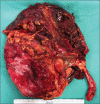Treatment of a hemorrhage secondary to nephrostomy tube placement for derivation of monstrous hydronephrosis in upper tract urothelial carcinoma
- PMID: 37304515
- PMCID: PMC10252770
- DOI: 10.4103/ua.ua_23_23
Treatment of a hemorrhage secondary to nephrostomy tube placement for derivation of monstrous hydronephrosis in upper tract urothelial carcinoma
Abstract
A 85-year-old female patient underwent nephrostomy tube insertion for a huge hydronephrosis due to a papillary mass involving the right ureteral ostium diagnosed by at computed tomography scan. As soon as the nephrostomy tube was inserted, a pulsatile bleeding was found and a renal angiography was done. A massive bleeding from the main and unique right renal artery was found such as to require prompt endovascular embolization. A transurethral resection of the bladder was performed and the pathology report confirmed high-grade pTa transitional cell carcinoma. An open drainage was then placed to empty the contents of the pyelocalyceal system of the kidney. Once obtained the volumetric reduction of the abdominal mass the patient underwent the right nephroureterectomy.
Keywords: Hydroureteronephrosis; percutaneous nephrostomy; radical nephroureterectomy; transcatheter arterial embolization; upper tract urothelial carcinoma.
Copyright: © 2023 Urology Annals.
Conflict of interest statement
There are no conflicts of interest.
Figures




References
-
- Messer JC, Terrell JD, Herman MP, Ng CK, Scherr DS, Scoll B, et al. Multi-institutional validation of the ability of preoperative hydronephrosis to predict advanced pathologic tumor stage in upper-tract urothelial carcinoma. Urol Oncol. 2013;31:904–8. - PubMed
-
- Ito Y, Kikuchi E, Tanaka N, Miyajima A, Mikami S, Jinzaki M, et al. Preoperative hydronephrosis grade independently predicts worse pathological outcomes in patients undergoing nephroureterectomy for upper tract urothelial carcinoma. J Urol. 2011;185:1621–6. - PubMed
-
- Rouprêt M, Babjuk M, Burger M, Capoun O, Cohen D, Compérat EM, et al. European Association of urology guidelines on upper urinary tract urothelial carcinoma:2020 update. Eur Urol. 2021;79:62–79. - PubMed
-
- Greenstein A, Kaver I, Chen J, Matzkin H. Does preoperative nephrostomy increase the incidence of wound infection after nephrectomy? Urology. 1999;53:50–2. - PubMed
Publication types
LinkOut - more resources
Full Text Sources
Research Materials
